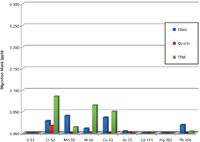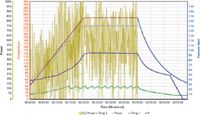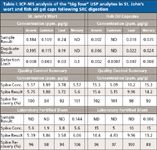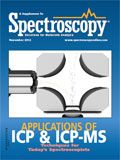The Application of Single-Reaction-Chamber Microwave Digestion to the Preparation of Pharmaceutical Samples in Accordance with USP <232> and <233>
Special Issues
Single-reaction-chamber (SRC) microwave digestion was used for the digestion of pharmaceutical samples before inductively coupled plasma–mass spectrometry (ICP-MS) analysis according to draft USP chapters <232> and <233>.
Single-reaction-chamber (SRC) microwave digestion was used for the digestion of pharmaceutical samples before inductively coupled plasma–mass spectrometry (ICP-MS) analysis according to draft USP chapters <232> and <233>. Following the optimization of digestion methodology (vial type, digestion matrix, and temperature program), dietary supplements were digested and analyzed for the "big four" toxic elements. Good quality control data demonstrates the suitability of SRC microwave digestion for this application.
New USP chapters <232> and <233> for the measurement of inorganic contaminants in pharmaceutical samples are scheduled to be implemented in early 2014. While samples that are soluble in aqueous and organic solvents may be analyzed directly, a large proportion of samples will require digestion; in fact, digestion may be preferred for inductively coupled plasma–mass spectrometry (ICP-MS) analysis even if the sample is soluble in organic solvent. Closed-vessel digestion is stipulated by USP and it is expected that microwave digestion will be the predominant digestion technique used; its high pressure and temperature capability offers greater digestion power than hot-plate closed-vessel digestion.
Single-reaction-chamber (SRC) microwave digestion is a relatively new type of closed-vessel digestion that differs significantly from traditional closed-vessel digestion. A commercially available benchtop SRC digestion system can digest as many as 15 samples simultaneously, at high temperature and pressure. This high temperature and pressure capability enables the complete digestion of virtually every pharmaceutical sample type, producing digest solutions with a very low total organic carbon (TOC) content, which is beneficial for ICP-MS analysis.
Two sample types, St. John's wort and fish oil, typical of finished product pharmaceuticals, were digested using an SRC digestion system and analyzed for the four toxic USP elements using collision-cell ICP-MS to evaluate the effectiveness of SRC digestion for this application. Because all samples are digested together in a single chamber with SRC, duplicates and spike recoveries were performed to confirm the retention of volatile elements and the absence of cross contamination.
Instrumentation
The SRC system features a large (typically 1-L) pressurized reaction chamber, which is also the microwave cavity. This enables the intensity and distribution of the delivered microwave energy to be optimized to the shape of the reaction vessel, which ensures even heating and eliminates the need to rotate samples during the digestion program. Samples are placed inside the microwave system together and digested simultaneously. Because the samples are placed inside a pressurized vessel, individual pressure vessels are not needed. Samples are weighed into autosampler-type vials with the appropriate digestion acid and loaded into a rack. Loose-fitting vial caps prevent condensation from the roof of the chamber dripping into the samples (the caps must be loose fitting to ensure pressure equalization within the chamber). The rack is loaded into the chamber, which is then sealed and prepressurized with nitrogen to 40 bar before microwave heating. Prepressurization prevents spitting or boiling of the sample solutions, which prevents cross contamination or loss of volatiles. Because the pressure in the chamber increases with sample temperature, boiling never occurs. An SRC system can operate at very high temperature and pressure — up to 300 °C and 199 bar, which enables the complete digestion of virtually every pharmaceutical sample type, including oils and whole gel caps. Samples with high organic content such as oils generate pressure in the microwave vessel because of the generation of NOX and CO2; in traditional microwave digestion, high pressure vessels (typically 100 bar) must be used. The higher pressure capability of an SRC system allows higher sample weights to be digested, including whole gel caps, which is a benefit for pharmaceutical sample analysis. With SRC microwave digestion, because all the samples are digested together under the same conditions, different sample types can be digested together — there is no need to "batch" digestion runs into identical sample types as with traditional microwave digestion. So raw materials, excipients, active pharmaceutical ingredients (API), and the final product can all be digested together in the same run.
SRC microwave digestion also requires less digestion acid (typically 2–4 mL), which lowers the reagent blank. After completion of the program, the chamber is vented and the rack is removed. Samples are diluted to volume in the vials, and are then ready for aliquotting and measurement. The SRC microwave system used in this work was a benchtop UltraWAVE instrument (Milestone Inc.). Figure 1 shows a flow diagram of the steps in an SRC digestion run.

Figure 1: Flow diagram of SRC operation. 1 = sample rack is lowered automatically into the microwave chamber, 2 = chamber clamp is secured, 3 = chamber is pressurized with inert gas to prevent boiling, 4 = microwave energy is applied, with all samples under the same temperature and pressure conditions, 5 = chamber is cooled by water cooling, vented, and acid vapors are extracted, 6 = clamp is released and rack automatically rises from chamber.
Method Optimization
Sample vials used in SRC instrumentation are typically available in quartz, TFM (a high temperature polymer from Dyneon), and borosilicate glass. The benefit of glass vials is that they are inexpensive and disposable, which eliminates the need for vial cleaning procedures. The drawback of glass vials is elevated backgrounds (parts-per-billion level) for some elements — namely B, Na, Mg, Al, K, and Ca. However, because these elements are not stipulated in USP <232>, glass vials can be used. Figure 2 shows the digestion blanks obtained from glass, quartz, and TFM digestion vials for USP elements. Ru, Os, and the Pt group elements were not measured, but it can be assumed that the vial contribution for these elements is extremely low.

Figure 2: Digestion blanks obtained from three different vial materials - selected USP elements.
The microwave program used applied to virtually all sample types: prepressurize with 40 bar nitrogen, ramp to 240 °C over 20 min, and hold for 20 min. Cool-down time was approximately 15 min, giving a total run time of 55 min. If all the samples in the run were easy to digest, the digestion temperature could be reduced to 200 °C, which reduced the cool-down time slightly. Figure 3 shows an actual SRC digestion run. The red line shows the temperature program with the actual temperature achieved during the run superimposed on it. The yellow line shows the applied microwave power, which is automatically adjusted by the instrument software so that the actual digestion temperature follows the program temperature. A proportional integral derivative (PID) controller adjusts the power automatically regardless of the number of samples in the run, acid volume, or sample weight. The blue line shows the pressure achieved during the run. Note that over 95 bar pressure is achieved, which is not possible in conventional closed-vessel digestion. Because the SRC system is capable of very high pressure, higher weights of high organic content sample can be digested, including whole gel caps, which, as we mentioned earlier, is a benefit for pharmaceutical sample analysis. Also, the higher pressure capability allows a higher temperature to be achieved, which gives a more complete digestion. Even for samples such as oils with high organic content, virtually all the organic carbon is decomposed to CO2, giving the sample digest a very low TOC content. This is a benefit for ICP-MS analysis because the presence of carbon in the sample enhances the sensitivity of poorly ionized elements. By removing the organic carbon, the analysis of poorly ionized elements becomes more predictable and reliable.

Figure 3: Results from a digestion run.
The digest matrix depends on the sample type and weight. Finished product capsules (St. John's wort) were composited and 0.5 g of sample was digested with 4 mL of HNO3 and 1 mL of HCl. For fish oil gel caps, an entire gel cap (1 g) was digested with 10 mL of HNO3 and 1 mL of HCl. The vial size used was 10 mL, allowing 15 samples to be digested simultaneously. Because all samples are digested together under the same pressure and temperature control, different sample weights and acid chemistries can be digested simultaneously. The only requirement is that the digestion temperature selected must be sufficient to digest the most difficult sample in the batch.
Sample Results
Samples of St. John's wort capsules and fish oil gel caps were digested as described above. The samples digested completely, forming a clear digestate, which was made up to 100 g with deionized water. The samples were analyzed for the USP "big four" toxic elements As, Cd, Pb, and Hg using an Agilent 7700x ICP-MS (Agilent Technologies) operated in helium collision mode. The validation of ICP-MS for USP <232> and <233> has been described previously (1). The use of HCl in the digestion helped to keep the stable Hg in solution while the use of collision mode removed the ArCl interference on As. The addition of HCl also stabilized the platinum group elements when the full USP element suite was measured. For QC, samples were analyzed in duplicate and a third aliquot was spiked. A reagent blank was also spiked (laboratory fortified blank). Quantitative data, 3-s detection limits, and QC data are shown in Table I.

Table I: ICP-MS analysis of the "big four" USP analytes in St. John’s wort and fish oil gel caps following SRC digestion
Quantitative values are expressed in micrograms per gram (parts per million). Duplicate analysis was generally good except for Hg in the fish oil gel caps which suggested possible variability of Hg content between gel caps (that is, the fish oil may have come from different sources). The 3-s detection limits used demonstrate detection limits at the low parts-per-trillion level in the sample as analyzed (dilution factor taken into account). Good recovery was obtained for the spiked samples and also for the spiked reagent blanks. The good recoveries for Hg demonstrate the effectiveness of prepressurization of the SRC system before the digestion sequence. Volatile elements such as Hg were not lost, and no cross contamination of samples occurred because of spitting or boiling.
Conclusion
SRC microwave digestion offers multiple benefits for sample preparation for trace metals analysis with USP <232> and <233>. Because of its higher sample capacity, use of disposable vials, and faster cool down time, sample processing throughput is 2–3× higher than conventional closed vessel digestion. The higher digestion quality and low TOC content of the digestates makes analysis by ICP-MS more accurate, and the ability to digest different sample types and higher sample weights together (even entire gel caps) makes it very convenient for pharmaceutical analysis.
References
(1) S. Hussain, L. Liba, and E. McCurdy, Spectroscopy supplement: Applications of ICP & ICP-MS Techniques for Today's Spectroscopists, 14 (November 2011).
Samina Hussain is with Exova Health Sciences in Santa Fe Springs, California.
Tim Michel is with Milestone Scientific in Shelton, Connecticut. Please direct correspondence to: tjm@milestonesci.com.

Best of the Week: AI and IoT for Pollution Monitoring, High Speed Laser MS
April 25th 2025Top articles published this week include a preview of our upcoming content series for National Space Day, a news story about air quality monitoring, and an announcement from Metrohm about their new Midwest office.
LIBS Illuminates the Hidden Health Risks of Indoor Welding and Soldering
April 23rd 2025A new dual-spectroscopy approach reveals real-time pollution threats in indoor workspaces. Chinese researchers have pioneered the use of laser-induced breakdown spectroscopy (LIBS) and aerosol mass spectrometry to uncover and monitor harmful heavy metal and dust emissions from soldering and welding in real-time. These complementary tools offer a fast, accurate means to evaluate air quality threats in industrial and indoor environments—where people spend most of their time.